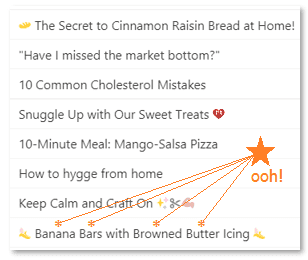[ad_1]
Searching for some alliteration examples to develop your writing repertoire?
This publish goes to be your go-to useful resource.
It’s full of examples from popular culture, sports activities, literature, and content material advertising that’ll encourage you to infuse alliteration into your individual writing.
You’ll additionally uncover:
- How alliteration helped you study letter sounds and develop reminiscence abilities if you had been younger;
- The variations between alliteration, assonance, and consonance;
- How freelance writers, bloggers, college students, entrepreneurs, and literary greats use alliteration to the touch the hearts and minds of readers.
Prepared? We’ll begin with a fast alliteration refresher.
What’s Alliteration?
Alliteration is a stylistic literary system that refers back to the repetition of intently linked collection of phrases which have the identical starting consonant sounds.
For instance, right here’s an all-too-true story that repeats the start “b” sound:
“Barbara baked banana bread, however it burned.”
(Bummer. )
Alliteration has been used for hundreds of years to breathe life into the written (and spoken) phrase by the impact of the sounds of phrases.
For instance, within the film “V for Vendetta”, V’s self-introduction takes alliteration to excessive. The impact of the string of “v” phrases definitely attracts consideration to his character by emphasis and tone:
The phrases of his speech inform his background story, however the repeated “v” sounds assist viewers get a way of his persona. The ominous impression of “V” is unforgettable.
This excessive instance of alliteration demonstrates the ability of verbal alliteration in movie, however this method has comparable results in written type.
Earlier than we dig into the advantages of alliteration, let’s check out alliteration’s shut cousins: assonance and consonance.
What’s the Distinction Between Alliteration, Assonance, and Consonance?
There are two sound-based literary units which can be similar to, and generally confused with, alliteration: assonance and consonance.
Assonance is the repetition of vowel sounds in a sentence, like “The squeaky wheel will get the grease.”
Consonance is the repetition of consonant sounds in a sentence, like “All’s well that ends well.”
Repetitive sounds are the frequent issue between alliteration, assonance and consonance. Alliteration differs from the opposite two as a result of it refers particularly to the primary consonant sounds in phrases.
What are the Advantages of Alliteration, Assonance, & Consonance?
Because of the repetitive element of alliteration, assonance, and consonance, they’re thought-about phonological mnemonic units, which assist to emphasise ideas and make passages extra memorable.
Sound-based literary units may assist to challenge a tone or temper with repeated sounds in phrases.
Alliteration is a multi-purpose literary system and its use can influence us in a wide range of methods.
Fact be advised, alliteration has benefited us from an early age, even earlier than we might learn.
The Evolution of Alliteration (in Our Lives)
Alliteration helps preschoolers study letter sounds and develop reminiscence abilities.
We’re first launched to alliteration by nursery rhymes and different kids’s poetry:
- “Three grey geese in a inexperienced area grazing…”
- “Betty Botter purchased some butter, however she mentioned, this butter’s bitter; if I put it in my batter, it should make my batter bitter, however a bit of higher butter will make my batter higher…”
Kids’s poet Shel Silverstein’s alliteratively titled “The Gnome, The Gnat and The Gnu” hints of repeated “n” sounds which can be discovered sprinkled all through his poem. His stylistic spelling additionally serves as a enjoyable option to educate kids that the letters “gn,” “kn” and “n” all make the identical sound:
I noticed an ol’ gnome
Take a gknock at a gnat
Who was gnibbling the gnose of his gnu.
I mentioned, “Gnasty gnome,
Gnow, cease doing that.
That gnat ain’t carried out gnothing to you.”
He gnodded his gnarled ol’ head and mentioned,
“‘Til gnow I gnever gnew
That gknocking a gnat
Within the gnoodle like that
Was gnot a gnice factor to do.”
Enjoyable alliterative tongue twisters problem kids’s fast-talking abilities:
- “Sally sells seashells on the seashore…”
- “Peter Piper picked a peck of pickled peppers…”
However alliterative kids’s poetry and tales do greater than merely educate phonics or entertain.
Whereas pondering pickled peppers, kids’s brains additionally work on associating meanings and emotional responses to sounds that they hear.
Intrigued? Learn on.
Sound Symbolism: Labeling a Sound
Sounds of phrases really reinforce their which means and affect the interpretation of our language. Sound Symbolism is the popularity of the idea that sounds have a sure inherent meanings and improve efficient communication.
So, how are these sound symbolisms developed?
Symbolism of sounds is derived partly from how we create sounds with our mouths and vocal chords. We categorize sounds with an “inside catalog” of facial actions associated to sure phrases mixed with our consciousness of how we bodily type sounds and phrases with our mouths.
Do this:
Type your mouth such as you’re going to say a phrase that begins with “sn.”
(Go forward, no one’s trying.)
You probably did that nasally pluggy-uppy maneuver along with your tongue, didn’t you?
We’ve related our nostril with the vocalization of the “sn” sound. Not coincidentally, many phrases which can be associated to the nostril and mouth begin with “sn,” like snore, snout, sniff, snoop and sneeze.
Skillful use of alliteration emphasizes a tone or temper by rhythmic repetition of sounds, eliciting a response to the “inside sound symbolism catalog” that all of us share.
Joni Mitchell wrote the alliterative opening track lyrics to her 1970 hit, “Large Yellow Taxi” to set the tone of her message. Take heed to the repeated “p” phrases that challenge her “spitting mad” temper about what’s occurring in her world:
“They paved paradise and put up a parking lot…”
Let’s check out some examples of alliteration in our on a regular basis lives that assist us bear in mind issues.
Pop Tradition: What’s in an Alliterative Identify?
Loads of science and thought is put into naming consumer products or brands. Listed below are some enterprise and model names which have apparent mnemonic qualities:
- Dunkin’ Donuts
- Krispy Kreme
- Bathtub & Physique Works
- Mattress, Bathtub & Past
- LuluLemon
- Coca-Cola
- Greatest Purchase
- American Airways
- PayPal
- American Attire
Sports activities group franchise names that make the all-alliteration group are:
- Los Angeles Lakers
- Buffalo Payments
- Pittsburgh Pirates (and Penguins)
- Seattle Seahawks
We regularly hear alliteration in music and movie artists’ names. These well-known tv, movie, sports activities and political figures got a pure edge on recognition with their alliterative names:
- Ronald Reagan
- Mickey Mantle
- Katie Courec
- Jesse Jackson
- Lucy Liu
We are able to solely marvel if Norma Jean Mortenson’s recognition and success was aided by the act of fixing her identify to Marilyn Monroe. Different movie star artists that adopted alliterative stage names are:
- Backstreet Boys
- Beastie Boys
- Dr. Dre
- Counting Crows
- Foo Fighters
Many fictitious characters in kids’s cartoons, books or films have alliterative names. To focus on his significance, major character Spongebob Squarepants’ identify is alliterative, however his associates’ names are usually not. Some others:
- Mickey Mouse & Minnie Mouse
- Large Chook
- Donald Duck
- Peppa Pig
- Bugs Bunny
Marvel Universe superheroes’ actual identities and supporting characters had been intentionally named alliteratively by creator, Stan Lee. Curiously, he admitted in an interview that he determined to make use of first and final names with the identical starting sounds to make it simpler to maintain them straight in his personal thoughts! To call just a few:
- Bruce Banner
- Reed Richards
- Sue Storm
- Peter Parker
- J. Jonah Jameson Jr.
- Fin Fang Foom
Harry Potter creator J. Okay. Rowling artfully named supporting characters utilizing varied literary units. Listed below are just a few examples of alliterative names within the collection:
- Luna Lovegood
- Severus Snape
- Salazar Slytherin
- Godric Gryffindor
- Helga Hufflepuff
Demonstrated by Ms. Rowling, the usage of alliteration in literature helps readers bear in mind characters in a narrative.
However writers may use alliteration to emphasise a passage or develop a sure tone by repeating comparable sounds. Let’s dive into some inventive alliteration examples in literary classics.
Examples of Alliteration in Literature
In poetry and prose, alliteration and different sound units like rhythm assist create a tone or temper, recommend a tempo, and emphasize sure phrases or phrases.
Alliteration In Poetry
This following stanza of The Rime of the Historical Mariner by Samuel Taylor Coleridge demonstrates his poetic use of sound-based literary units in his work. Alliteration ties the phrases of the poem collectively in addition to creating rhythmic and nice sounds:
“The truthful breeze blew, the white foam flew,
The furrow adopted free;
We had been the primary that ever burst
Into that silent sea.”
Alliteration helps to recommend an eerie rhythm of Edgar Allan Poe’s poem, “The Raven.” Discover the alliteration pairs within the first three stanzas:
“As soon as upon a midnight dreary, whereas I contemplated, weak and weary,
Over many a quaint and curious quantity of forgotten lore—
Whereas I nodded, practically napping, immediately there got here a tapping,…”
William Shakespeare used “f” sounds and “l” sounds to create pictures of dying and life, respectively, in his prologue of “Romeo and Juliet”:
“From forth the deadly loins of those two foes;
A pair of star-cross’d lovers take their life.”
Alliteration In Prose
In “To Kill a Mockingbird”, Harper Lee used alliterative descriptions of households and locations to emphasise the significance of those entities in her novel. With a heavy emphasis on “s” sounds, the city of Maycomb is described:
“…grass grew on the sidewalks, the courthouse sagged within the sq.… a black canine suffered on a summer season’s day; bony mules… flicked flies within the sweltering shade of the dwell oaks on the sq.…”
Alliteration In Speeches
Attributable to its rhetorical nature, alliteration seems in lots of well-known speeches during which sound-based literary units like alliteration assist to set a tone.
For instance, Abraham Lincoln’s Gettysburg Deal with opens demanding consideration with repetitive “f”sounds:
“4 rating and 7 years in the past our fathers introduced forth on this continent a new nation…”
One other instance is Martin Luther King’s “I Have a Dream” speech, which emphasised his dream for his kids by repeating the onerous “c” sound:
“I’ve a dream that my 4 little kids will someday dwell in a nation the place they won’t be judged by the coloration of their pores and skin however by the content material of their character.”
These traditional examples show that alliteration, used with different literary units, helps readers develop sensory and emotional connections with phrases. That connection in flip helps to construct a stronger understanding of the passages.
Able to see how up to date content material writers artfully use alliteration to emotionally join with their readers?
Examples of Alliteration in Content material Advertising and marketing
Everyone knows that the aim of content material advertising is to make a reference to our readers and encourage them to take motion.
To that finish, we’ve realized that we will use alliteration, power words, sensory words, and different writing units and instruments to create sensory and emotional connections with our readers. This emotional connection can assist persuade our readers to take motion.
Alliteration helps name consideration to headlines, subheads, and e mail topic traces, however alliteration may assist to emphasise some extent:
“Sensible audio system, in addition to their speechwriters, sprinkle their speeches with carefully-chosen energy phrases…”
– Jon Morrow
Let’s really feel the ability of some alliterative topic traces:
Pack a Punch With Alliterative Headlines
Alliterative phrases in these headlines name consideration to the message and emphasize their goal by alliteration:
And, this energy phrases headline will get alliteration bonus factors:
The rapid-succession Pack-a-Punch and Convert-like-Loopy plosive alliteration combo exerts an authoritative affect of Energy just like the previous one-two. (Onerous starting consonant sounds create a way of authority, however extra on that later.)
Cease Scanners with Alliterative Subheads
Subheads serve a number of functions, primarily to assist manage your content material for the reader. Alliteration can cease “subhead scanners” of their tracks by eliciting an emotional connection by sound symbolism, like these:
This one calls for consideration:
Polish Your Publish So It’s Smoother Than a Slip ‘n Slide
– from How to Write a Blog Post in 2020: The Ultimate Guide
And this subhead…
Make Cash by Creating Collateral for Content material-Hungry Enterprise
– from How to Make Money Writing: 5 Ways to Get Paid to Write in 2020
…leads readers into this alliterative textual content:
“Within the final 5 years, content material advertising — this idea of creating precious content material to draw clients and construct credibility and belief — has undoubtedly gone mainstream.”
Get Intelligent With Alliterative Calls to Motion
E mail topic traces that use alliteration spark a name to motion by projecting a sure tone or temper, connecting with the reader on an emotional or sensory stage.
Listed below are some intelligent alliterative topic traces of e mail acquired whereas sheltering in place through the COVID-19 pandemic:

These alliteration examples present us how we will make a memorable influence by emphasizing some extent or projecting a sense or a temper.
Able to put alliteration to the check? Let’s begin with somewhat experiment.
Alliteration: Testing the Tone
However how can we use alliteration in content material writing to be extra persuasive and memorable?
Circling again to the idea of sound symbolism, we realized that sounds have inherent meanings. Let’s see how efficient these inherent meanings are after they’re emphasised in alliterative phrases.
If you happen to recall, we acknowledged the power of the alliterative starting phrase sounds in:
801+ Energy Phrases That Pack a Punch and Convert like Loopy
However not all sounds are created equally.
To show, we’ve changed the unique alliteration with different alliterative phrases that specific the same idea:
XX Energy Phrases That’ll Steal the Present and Woo like Marvel
Our revised alliterative headline falls flat as a result of sibilant “s” and ethereal “w” sounds aren’t as authoritative as the unique plosive “p” and onerous “c” sounds.
Clearly, we have to take note of projected tones of sounds when utilizing alliteration.
Alliteration Results: The best way to Use Them
Reverse-engineering profitable alliteration begins with understanding the impact of starting phrase sounds.
Match the Sound to the Temper
Starting consonant sounds are related to a mix of two bodily actions after we vocalize the sound:
- Voiced or Unvoiced (whether or not the vocal cords are used to make the sound), and
- Fricatives vs. Stops (whether or not or not air is pushed from or stopped on the mouth).
Onerous consonant sounds which can be usually unvoiced or stops, and could have a plosive sound that may elicit a sense of authority or abruptness.
Conversely, some smooth consonant sounds are usually voiced or fricatives. They are often smooth and breathy, eliciting a extra soothing tone. Different smooth consonant appears like “s” or “z” are sibilant, suggesting malice or slyness.
Alliteration Tip #1:
A key to profitable use of alliteration is to match the impact of starting sounds of phrases to challenge the specified impact of your writing.
Check Out A Instrument
Caught for an alliteration?
Poem Generator has a number of writing aids to recommend phrases or passages to writers. Amongst these instruments is an Alliteration Generator. Merely key in a phrase or sentence that you just’d wish to alliterate, and the generator returns a listing of choices.
We examined the software by getting into:
“Let the software do the work.”
Our outcomes included a number of choices together with:
“Let the drained, reliable software do the wood, witty work.”
Clearly, a software doesn’t possess your creativity and judgement, so use it as an help as an alternative of an finish. Outcomes fluctuate!
Alliteration Tip #2:
Solicit the assistance of alliteration mills to recommend alliterative phrases, however do not forget that your creativity far outweighs any software program program.
Give It a Go, However Don’t Go Gaga
When you get the cling of alliteration, you could be tempted to make use of it extra usually than it’s best to. Don’t!
Merely mentioned, sentences with a surplus of comparable sounds will sound foolish and considerably silly!
Alliteration Tip #3:
Don’t go overboard with alliteration in your writing. Like all highly effective instruments, you could use alliteration sparingly.
Add Alliteration to Your Toolkit
Able to make higher connections along with your readers?
Draw your inspiration from these alliteration examples to assist your readers really feel the impact of your message.
Keep in mind, alliteration is all about sound. Sound can assist you emphasize a key level or convey a tone by intentionally deciding on appropriate phrases. Make a sensory influence by deciding on starting phrase sounds for his or her symbolism and repeating them to accentuate the impact.
Then, take pleasure in your work’s alliterative transition from:
- uninteresting to dramatic,
- trite to tantalizing or
- boring to badass!
You get the thought!
[ad_2]





